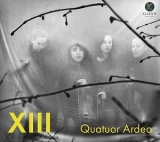 XIII; Claudio Monteverdi: Hor che'l ciel e la terra SV147; Franz Schubert: Streichquartett Nr. 13 D. 804 (Rosamunde); Henry Purcell: Pavane Z.752 + Chaconne Z.730; Franz Schubert / Quatuor Ardeo: Der Tod und das Mädchen D. 531; George Crumb: Black Angels; Franz Schubert / Quatuor Ardeo: Die Götter Griechenlands D. 677; Quatuor Ardeo (Carole Petitdemange, Mi-Sa Yang, Yuko Hara, Joëlle Martinez) 1 CD Klarthe K104; Aufnahme 02/2020, Veröffentlichung 04/09/2020 (68') - Rezension von Remy Franck
XIII; Claudio Monteverdi: Hor che'l ciel e la terra SV147; Franz Schubert: Streichquartett Nr. 13 D. 804 (Rosamunde); Henry Purcell: Pavane Z.752 + Chaconne Z.730; Franz Schubert / Quatuor Ardeo: Der Tod und das Mädchen D. 531; George Crumb: Black Angels; Franz Schubert / Quatuor Ardeo: Die Götter Griechenlands D. 677; Quatuor Ardeo (Carole Petitdemange, Mi-Sa Yang, Yuko Hara, Joëlle Martinez) 1 CD Klarthe K104; Aufnahme 02/2020, Veröffentlichung 04/09/2020 (68') - Rezension von Remy Franck
Der Titel dieses Albums bezieht sich auf Schuberts Rosamunde-Quartett, das 13. der 15 Quartette des Komponisten, und die Zahl 13 spielt ebenfalls eine wesentliche Rolle, sowohl strukturell als auch symbolisch, in Crumbs Black Angels, dem Werk, um das herum das Programm dieser Produktion strukturiert ist.
Eingeleitet wird die CD mit der Transkription des dreizehnten der Madrigali Guerrieri ed Amorosi von Monteverdi. Es folgt eine ebenso tiefschürfende wie gut gespielte Interpretation des Rosamunde-Quartetts von Franz Schubert. Das reine Damenquartett Ardeo (aus dem Lateinischen Ich brenne) lässt in Bezug auf Intonation, Homogenität und Balance zwischen den Instrumenten sowie an Musikalität und Engagement nichts zu wünschen übrig. Details werden klar herausgearbeitet, Effekte vermieden, ohne dass die Rhetorik darunter leiden würde. Besonders schön finde ich den melancholischen und wehmütigen Charakter des zweiten Satzes, den mit dem Rosamunde-Thema.
Weitere eigene Transkriptionen von zwei Purcell-Stücken und Schuberts Lied Der Tod und das Mädchen führen zu Black Angels, einem 1970 von George Crumb komponierten Werk, die ausdrücklich Bezug auf das Schubert-Lied nimmt. Das sehr ungewöhnliche Quartett ist eine Anprangerung des Vietnam-Krieges und eine eindringliche Reflexion über den Tod, mit dem Untertitel ‘Thirteen Images from the Dark Land for Electric String Quartet’.
« Friday the 13th, March 1970 (in tempore belli) » steht auf der Partitur. In 13 symbolischen Bildern entfaltet sich als Klagelied. Napalm werfende Helikopter liefern den Titel, und in der manchmal chaotischen, oft aber auch sehr reflektiven Musik werden Schuberts Der Tod und das Mädchen und das Dies Irae-Motiv zitiert. Neben den Streichinstrumenten sind Stimmen, Gläser und Tam-Tam-Gongs zu hören. Das Ardeo Quartett beeindruckt in diesem ungemein spannenden Quartett mit einer faszinierend intensiven Aufführung.
Ein weiteres Schubert Lied, klar und scharf gespielt, beendet das intelligent zusammengesetzte und vorzüglich gespielte Programm.
The title of this album refers to Schubert’s Rosamunde Quartet, the 13th of the composer’s 15 quartets, and the number 13 plays also an essential role, both structurally and symbolically, in Crumb’s Black Angels, the work around which the programme of this recording is structured.
The CD opens with the transcription of the thirteenth of the Madrigali Guerrieri ed Amorosi by Monteverdi. This is followed by an interpretation of Franz Schubert’s Rosamunde Quartet that is as profound as it is well played. The all-female quartet Ardeo (from the Latin « I burn ») leaves nothing to be desired in terms of intonation, homogeneity, balance, musicality and commitment. Details are worked out clearly, effects are avoided without the rhetoric suffering. I especially like the melancholic and melancholy character of the second movement, the one with the Rosamunde theme.
Further own transcriptions of two Purcell pieces and Schubert’s song Der Tod und das Mädchen lead to Black Angels, a work composed by George Crumb in 1970, which explicitly refers to the Schubert song. The very unusual quartet is a denunciation of the Vietnam War and a haunting reflection on death, subtitled ‘Thirteen Images from the Dark Land for Electric String Quartet’.
The composer wrote « Friday the 13th, March 1970 (in tempore belli) » on the score, a lament in 13 symbolic images. Napalm throwing helicopters provide the title, and in the sometimes chaotic, but often also very reflective music Schubert’s Death and the Maiden and the Dies Irae motif are quoted. In addition to the string instruments, voices, glasses and tam-tam gongs can be heard. The Ardeo Quartet delivers a fascinatingly intense performance by this incredibly exciting quartet.
Another Schubert song, played clearly and sharply, concludes the intelligently composed and excellently played programme.
























